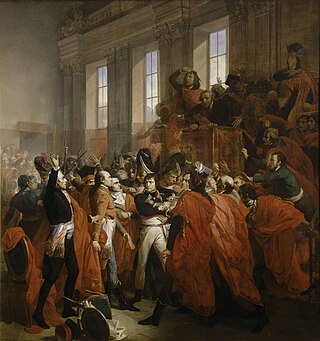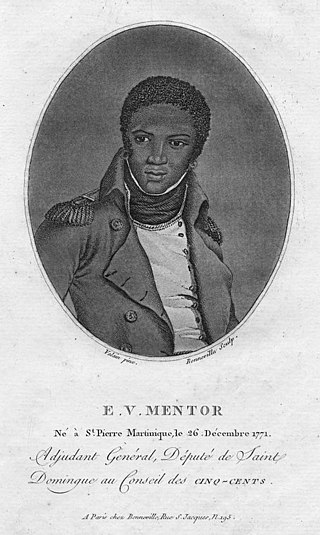
The Directory was the governing five-member committee in the French First Republic from 26 October 1795 until November 1799, when it was overthrown by Napoleon Bonaparte in the Coup of 18 Brumaire and replaced by the Consulate. In mainstream historiography, the term Directoire is also used to refer to the period, coinciding with the final four years of the French Revolution.

Jean-François Reubell or Rewbell was a French lawyer, diplomat, and politician of the Revolution.

Jean-Charles Pichegru was a French general of the Revolutionary Wars. Under his command, French troops overran Belgium and the Netherlands before fighting on the Rhine front. His royalist positions led to his loss of power and imprisonment in Cayenne, French Guiana during the Coup of 18 Fructidor in 1797. After escaping into exile in London and joining the staff of Alexander Korsakov, he returned to France and planned the Pichegru Conspiracy to remove Napoleon from power, which led to his arrest and death. Despite his defection, his surname is one of the names inscribed under the Arc de Triomphe, on Column 3.

The following is a timeline of the French Revolution.

The Consulate was the top-level government of France from the fall of the Directory in the coup of 18 Brumaire on 9 November 1799 until the start of the French Empire on 18 May 1804. By extension, the term The Consulate also refers to this period of French history.
This glossary of the French Revolution generally does not explicate names of individual people or their political associations; those can be found in List of people associated with the French Revolution.

The Coup of 18 Brumaire brought Napoleon Bonaparte to power as First Consul of France. In the view of most historians, it ended the French Revolution and would soon lead to the coronation of Napoleon as emperor. This bloodless coup d'état overthrew the Directory, replacing it with the French Consulate. This occurred on 9 November 1799, which was 18 Brumaire, Year VIII under the short-lived French Republican calendar system.

Philippe-Antoine Merlin, known as Merlin de Douai, was a French politician and lawyer.

The Council of Ancients or Council of Elders was the upper house of the French legislature under the Constitution of the Year III, during the period commonly known as the Directory, from 22 August 1795 until 9 November 1799, roughly the second half of the period generally referred to as the French Revolution.

The Constitution of the Year III was the constitution of the French First Republic that established the Executive Directory. Adopted by the convention on 5 Fructidor Year III and approved by plebiscite on 6 September. Its preamble is the Declaration of the Rights and Duties of Man and of the Citizen of 1789.

The Constitution of the Year VIII was a national constitution of France, adopted on 24 December 1799, which established the form of government known as the Consulate. The coup of 18 Brumaire had effectively given all power to Napoleon Bonaparte, and in the eyes of some, ended the French Revolution.
The Coup of 30 Prairial Year VII, also known as the Revenge of the Councils was a bloodless coup in France that occurred on 18 June 1799—30 Prairial Year VII by the French Republican Calendar. It left Emmanuel-Joseph Sieyès as the dominant figure of the French government, and prefigured the coup of 18 Brumaire that brought Napoleon Bonaparte to power.
Legislative elections were held in France between 9 and 18 April 1798 to elect one-third of the members of the Council of Five Hundred and the Council of Ancients, the lower and upper houses of the legislature, as well as 201 vacant seats. They marked the beginning of the end of the French far-left and rise of the anti-Montagnard and anti-Jacobin groupings. The 1798 elections were partially invalidated by the passage of the Law of 22 Floréal Year VI which saw 106 Montagnards lose their seats by decree of the Council of Five Hundred.
Legislative elections were held in France between 12 and 21 October 1795 to elect one-third of the members of the Council of Five Hundred and the Council of Ancients, the lower and upper houses of the legislature. The elections were held in accordance with the Constitution of the Year III and the first under the Directory regime.

Jean-Antoine Marbot, also known to contemporaries as Antoine Marbot, was a French general and politician. He belongs to a family that has distinguished itself particularly in the career of arms, giving three generals to France in less than 50 years.

The Coup of 18 Fructidor, Year V, was a seizure of power in France by members of the Directory, the government of the French First Republic, with support from the French military. The coup was provoked by the results of elections held months earlier, which had given the majority of seats in the country's Corps législatif to royalist candidates, threatening a restoration of the monarchy and a return to the ancien régime. Three of the five members of the Directory, Paul Barras, Jean-François Rewbell and Louis Marie de La Révellière-Lépeaux, with support of foreign minister Charles Maurice de Talleyrand-Périgord, staged the coup d'état that annulled many of the previous election's results and ousted the monarchists from the legislature.

Étienne Victor Mentor was a politician from Martinique who served and represented Saint-Domingue in the French parliament from 1797-1799.

Dominique-Vincent Ramel was a French lawyer and politician who became Minister of Finance under the French Directory. He was an energetic reformer, but was blamed for many of the financial problems of the time, and went into retirement during the French Consulate and First French Empire. He supported Napoleon during the Hundred Days of 1815. After the second Bourbon Restoration, as a regicide he was forced into exile in Belgium, where he died without returning to France.
Jean Adrien Bigonnet (1755–1832) was a French revolutionist and republican who became a member of the Council of Five Hundred (1795–1799).

Amédée Willot, Count of Gramprez, held several military commands during the French Revolutionary Wars but his association with Jean-Charles Pichegru led to his exile from France in 1797. He joined the French Royal Army as a volunteer in 1771 and was a captain by 1787. He was elected commander of a volunteer battalion in 1792 and served in the War of the Pyrenees. Shortly after being promoted commander of a light infantry regiment Willot was appointed general of brigade in June 1793. A few months later he was denounced as a Royalist and jailed. In the light of later events, this may have been an accurate assessment of Willot's sentiments. After release from prison in January 1795, he led troops in Spain during the summer campaign. He was promoted to general of division in July 1795.



















